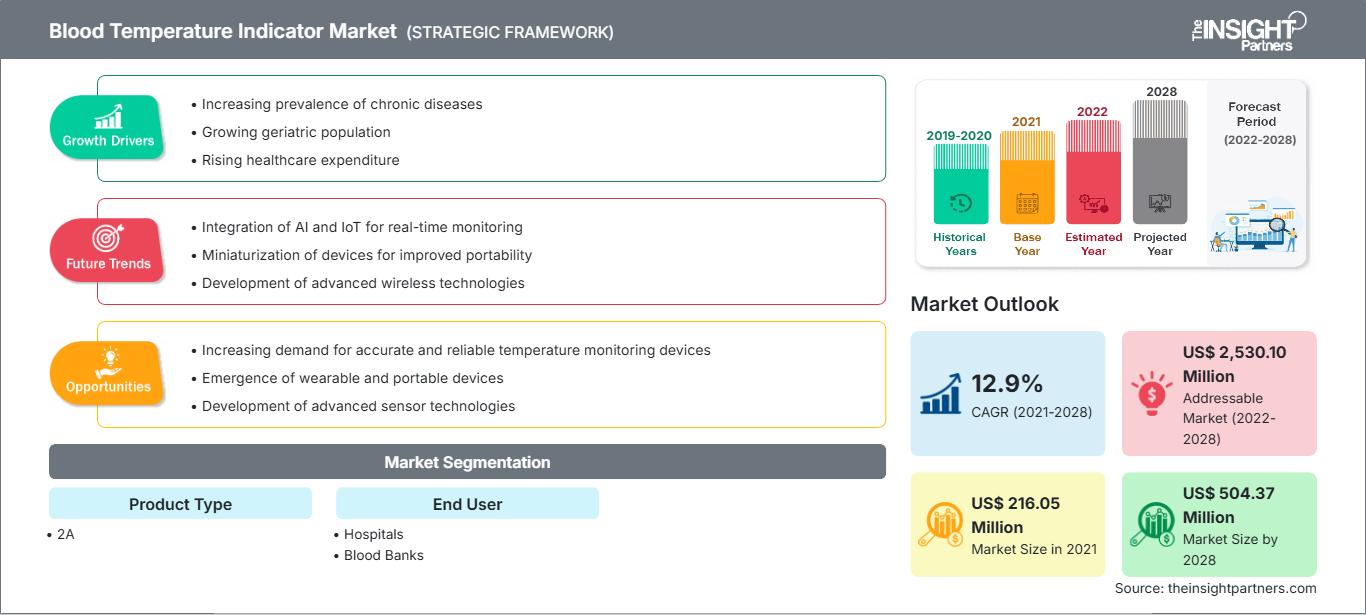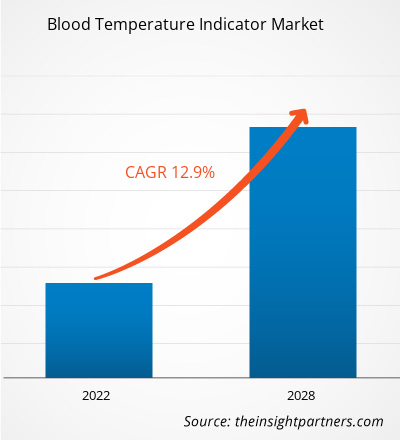Der Markt für Bluttemperaturindikatoren soll von 216,05 Millionen US-Dollar im Jahr 2021 auf 504,37 Millionen US-Dollar im Jahr 2028 wachsen; von 2021 bis 2028 wird eine durchschnittliche jährliche Wachstumsrate (CAGR) von 12,9 % erwartet.
Bluttemperaturindikatoren sind kleine medizinische Geräte oder Lösungen, die durch den effektiven und effizienten Transport von Blut und Blutbestandteilen zur Erhöhung der Blutsicherheit beitragen. Diese Indikatoren liefern einen überprüfbaren Nachweis, dass Blut gemäß den gesetzlichen Standards gelagert und transportiert wird, was die Blutverschwendung weiter reduziert.
Der Bericht bietet Einblicke und eine detaillierte Analyse des Marktes für Bluttemperaturindikatoren und hebt dabei verschiedene Parameter wie Markttrends, technologische Fortschritte und Marktdynamik hervor. Er enthält außerdem eine Analyse der Wettbewerbslandschaft führender Marktteilnehmer und die Auswirkungen der COVID-19-Pandemie auf den Markt für Bluttemperaturindikatoren in allen wichtigen Regionen. Die COVID-19-Pandemie hat die sozioökonomischen Bedingungen verschiedener Länder weltweit erschüttert. Laut WHO-Statistiken von 2021 sind die USA das weltweit am schlimmsten von der COVID-19-Pandemie betroffene Land und weisen die höchste Zahl an COVID-19-Fällen auf. Die hohe Fallzahl hat die Wirtschaft Nordamerikas, insbesondere der USA, beeinträchtigt. Die COVID-19-Pandemie hat zu entscheidenden technologischen Veränderungen geführt, um eine bessere medizinische Versorgung zu gewährleisten. Aufgrund der Ausbreitung von SARS-CoV-2 wurden viele Städte abgeriegelt, was zu Behandlungsabsagen bei Ärzten und Chirurgen führte. Die COVID-19-Pandemie hat aufgrund der Unterbrechung der Lieferketten weltweit die Herstellung und Lieferung von Bluttemperaturindikatoren beeinträchtigt. Darüber hinaus priorisieren medizinische Fachkräfte Notfallmaßnahmen und haben alle geplanten Operationen abgesagt, um die Ausbreitung des Coronavirus zu verhindern.
Im Jahr 2020 erlaubte die Food and Drug Administration (FDA) die Notfallverwendung von Rekonvaleszentenplasma zur Behandlung von COVID-19-Patienten, was zu einem Anstieg der Blutspenden führte. Darüber hinaus wird erwartet, dass die Präsenz wichtiger Marktteilnehmer und ihre verschiedenen strategischen Kooperationen auf dem Markt für Bluttemperaturindikatoren das Marktwachstum unterstützen. So bringt Timestrip, der Entwickler intelligenter Temperaturanzeigetechnologie, eine völlig neue Produktreihe mit zwei elektronischen Temperaturanzeigern auf den Markt. Diese Anzeiger werden für die Überwachung der sicheren Lagerung und des Transports verschiedener Güter, darunter Arzneimittel, Impfstoffe, Gesundheitsprodukte, Lebensmittel, Klebstoffe und Tinten, von entscheidender Bedeutung sein. Die COVID-19-Pandemie wirkte sich daher negativ auf den Markt für Bluttemperaturanzeiger aus.
Regional unterteilt sich der Markt für Bluttemperaturanzeiger in Nordamerika, Europa, Asien-Pazifik, den Nahen Osten und Afrika sowie Süd- und Mittelamerika.
Passen Sie diesen Bericht Ihren Anforderungen an
Sie erhalten kostenlos Anpassungen an jedem Bericht, einschließlich Teilen dieses Berichts oder einer Analyse auf Länderebene, eines Excel-Datenpakets sowie tolle Angebote und Rabatte für Start-ups und Universitäten.
Markt für Bluttemperaturindikatoren: Strategische Einblicke

-
Holen Sie sich die wichtigsten Markttrends aus diesem Bericht.Dieses KOSTENLOSE Beispiel umfasst Datenanalysen, die von Markttrends bis hin zu Schätzungen und Prognosen reichen.
Markteinblicke
Zunahme von Bluttransfusionen und -spenden treibt den Markt für Bluttemperaturindikatoren an
Bluttransfusionen gehören zu den im Gesundheitswesen am häufigsten angewandten Verfahren und dienen der Aufrechterhaltung des Blutspiegels von Patienten. Verschiedene chronische Erkrankungen, chirurgische Eingriffe und Traumata erfordern eine Bluttransfusion, damit die Patienten ohne Nebenwirkungen aufgrund eines niedrigen Blutspiegels überleben können. Erkrankungen wie Thalassämie, Blutkrebs, Sichelzellenanämie, Anämie sowie chirurgische Eingriffe und Traumata führen zu Blutverlust und erfordern eine Bluttransfusion. Nach Angaben des Amerikanischen Roten Kreuzes werden in den USA jährlich etwa 16 Millionen Blutkomponenten transfundiert. Darüber hinaus sind in den USA 90.000 bis 100.000 Menschen von Sichelzellenanämie betroffen; etwa 1.000 Babys werden jedes Jahr mit dieser Krankheit geboren. Die zunehmende Verbreitung chronischer Krankheiten hat die Nachfrage nach Bluttransfusionen erhöht, was das Wachstum des Marktes für Bluttemperaturindikatoren voraussichtlich vorantreiben wird.
Nach der Entnahme muss Blut unter bestimmten Bedingungen und Temperaturen gelagert und transportiert werden. Wird das Blut längere Zeit außerhalb dieses Temperaturbereichs gelagert und transportiert, verliert es seine Fähigkeit, Sauerstoff zu transportieren, was zu ernsthaften Problemen führen kann. Darüber hinaus besteht das Risiko einer schweren bakteriellen Kontamination, wenn das Blut hohen Temperaturen ausgesetzt wird. Bluttemperaturindikatoren spielen eine wichtige Rolle bei der Aufrechterhaltung der erforderlichen Bedingungen und Temperaturen für den sicheren und zuverlässigen Transport von Blut und seinen Bestandteilen. Durch die genaue Überwachung der Temperatur und die Gewährleistung der Blutsicherheit während des Transports verringern sie das Risiko des Blutverderbs. Steigende Bluttransfusionen und Blutspenden sowie die steigende Nachfrage nach sicherem Transport von Blut und Blutbestandteilen führen zu einer Nachfrage nach Bluttemperaturindikatoren, die das Marktwachstum antreibt.
Produkttypbasierte Erkenntnisse
Basierend auf dem Produkttyp ist der Markt für Bluttemperaturindikatoren in 2 °C bis 4 °C, 5 °C bis 7 °C und über 7 °C segmentiert. Im Jahr 2021 hatte das Segment 2 °C bis 4 °C den größten Marktanteil. Die Marktposition dieses Segments hat sich aufgrund seiner häufigen Verwendung beim Langstreckentransport von Blut verbessert. Beispielsweise muss gemäß den wichtigsten europäischen und amerikanischen Richtlinien die Temperatur von Erythrozytenbeuteln während der Lagerung zwischen 1 °C und 6 °C und während des Transports zwischen 1 °C und 10 °C liegen.
Markt für Bluttemperaturindikatoren
Die Analysten von The Insight Partners haben die regionalen Trends und Faktoren, die den Markt für Bluttemperaturindikatoren im Prognosezeitraum beeinflussen, ausführlich erläutert. In diesem Abschnitt werden auch die Marktsegmente und die geografische Verteilung von Bluttemperaturindikatoren in Nordamerika, Europa, dem asiatisch-pazifischen Raum, dem Nahen Osten und Afrika sowie Süd- und Mittelamerika erläutert.Umfang des Marktberichts zu Bluttemperaturindikatoren
| Berichtsattribut | Einzelheiten |
|---|---|
| Marktgröße in 2021 | US$ 216.05 Million |
| Marktgröße nach 2028 | US$ 504.37 Million |
| Globale CAGR (2021 - 2028) | 12.9% |
| Historische Daten | 2019-2020 |
| Prognosezeitraum | 2022-2028 |
| Abgedeckte Segmente |
By Produkttyp
|
| Abgedeckte Regionen und Länder |
Nordamerika
|
| Marktführer und wichtige Unternehmensprofile |
|
Dichte der Marktteilnehmer für Bluttemperaturindikatoren: Verständnis ihrer Auswirkungen auf die Geschäftsdynamik
Der Markt für Bluttemperaturindikatoren wächst rasant. Dies wird durch die steigende Nachfrage der Endverbraucher aufgrund veränderter Verbraucherpräferenzen, technologischer Fortschritte und eines stärkeren Bewusstseins für die Produktvorteile vorangetrieben. Mit der steigenden Nachfrage erweitern Unternehmen ihr Angebot, entwickeln Innovationen, um den Bedürfnissen der Verbraucher gerecht zu werden, und nutzen neue Trends, was das Marktwachstum weiter ankurbelt.

- Holen Sie sich die Markt für Bluttemperaturindikatoren Übersicht der wichtigsten Akteure
Einblicke für Endnutzer
Basierend auf dem Endnutzer ist der Markt für Bluttemperaturindikatoren in Krankenhäuser, Blutbanken und andere segmentiert. Das Krankenhaussegment dominierte den Markt im Jahr 2021.
Die Akteure auf dem Markt für Bluttemperaturindikatoren verfolgen organische Strategien wie Produkteinführung und -erweiterung, um ihre Präsenz und ihr Produktportfolio weltweit zu erweitern.
Firmenprofile
- Elitech
- Thero Fisher Scientific Inc.
- Sercalia
- Ellab Group
- Zebra Technologies Corporation
- Lisaline Lifesciences Technologies
- Stream Peak International PTE Ltd
- 3M
- DeltaTrak Inc.
- TimeStrip UK Ltd
- Historische Analyse (2 Jahre), Basisjahr, Prognose (7 Jahre) mit CAGR
- PEST- und SWOT-Analyse
- Marktgröße Wert/Volumen – Global, Regional, Land
- Branchen- und Wettbewerbslandschaft
- Excel-Datensatz
Aktuelle Berichte
Verwandte Berichte
Erfahrungsberichte
Grund zum Kauf
- Fundierte Entscheidungsfindung
- Marktdynamik verstehen
- Wettbewerbsanalyse
- Kundeneinblicke
- Marktprognosen
- Risikominimierung
- Strategische Planung
- Investitionsbegründung
- Identifizierung neuer Märkte
- Verbesserung von Marketingstrategien
- Steigerung der Betriebseffizienz
- Anpassung an regulatorische Trends






















 Kostenlose Probe anfordern für - Markt für Bluttemperaturindikatoren
Kostenlose Probe anfordern für - Markt für Bluttemperaturindikatoren